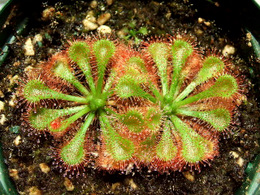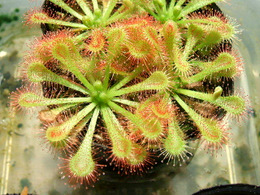Drosera tokaiensisDrosera tokaiensis is a natural hybrid between Drosera spatulata and Drosera rotundifolia. While the names D. x tokaiensis and D. tokaiensis are both used, this plant is a self-fertile autopolyploid and produces many viable seeds through self-pollination. Drosera tokaiensis is unlike D. rotundifolia in that it does NOT need dormancy, but it can go dormant if subjected to the right conditions (i.e. low temperatures). Give this rosetted sundew subtropical conditions for best results. I recommend Drosera tokaiensis for any beginning sundew grower. Drosera tokaiensis is exceptionally fast (can flower at only 4 months old) and easy to grow from seed, so I recommend it to any new sundew grower who would like to give sundew seeds a shot. Under bright light, Drosera tokaiensis will develop beautiful coloration. Another hybrid Drosera tokaienis x rotundifolia, does require dormancy. |
|
| Drosera tokaiensis exhibiting red coloration An overhead view of Drosera tokaiensis  Drosera tokaiensis (Saita)  Drosera tokaiensis (Mitoyo) |
Media: Can grow well in pretty much any medium. I have successfully grown Drosera tokaiensis in 1 peat: 1 sand, pure Long-fibered sphagnum (LFS) 1 LFS: 1 perlite. Be sure to rinse your media before you use it Media moisture: can grow well in very wet soils. Adaptable to drier conditions as well. Humidity: not much needed. I'd recommend at least 50%. Pot height: Drosera tokaiensis can grow well in pretty much any size pot. I always recommend 4 inches or taller for the best results, and maximum growth. Trapping speed: moderate. Leaves will curl and fold drastically around food within a few hours. Feeding: Feed your Drosera tokaiensis once every two weeks for rapid, robust growth and flower production. See feeding page. Feeding encourages flowering. Food size: medium Plant dimensions: Drosera tokaiensis is a rosetted sundew, remaining about 1.25 inches across at maturity. Temperature: not picky. Has grown well for me in the temp range of 45-90 degrees F. Give Drosera tokaiensis subtropical conditions. In nature, this plant can tolerate temps up to 100 degrees during the summer months. Lighting/Photoperiod: I grow mine under T-8 lights with a 16-hour photoperiod. Drosera tokaiensis will turn bright red in intense light. Dormancy requirements: None required. I've grown my plants for 3 years under lights without any ever going dormant. If subjected to cold temperatures in the mid 30 degrees F for extended periods of time, this plant may form a hibernacula. I recommend using the tray method. Drosera tokaiensis should come back from the roots if it suddenly freezes and warms up again, or if the media dries out completely. Very hard to permanently kill once established. Flowers: Drosera tokaiensis is one of the best self-pollinating sundews. There are normally 15+ flowers on its tall stalk, with each flower containing up to 40+ seeds. Propagation Techniques(click here to learn more about propagating sundews)Seed: extremely easy. no cold stratification required. Can be grown to flowering maturity from seed in around 4 months (if fed often)! Drosera tokaiensis was one of the first sundews I tried to grow from seed. Despite my abuse, my first batch flowered after 8 months. Leaf-cuttings: very easy. The water-floating method works best. Place directly under lights for the hightest success rate. Root cuttings: Very easy. Roots are a bit more slender than D. capensis, but they work extremely well. Divisions: very easy. Drosera tokaiensis tends to form clumps over time, when the seeds scatter everywhere. Drosera tokaiensis has no trouble dealing with repotting and root disturbance, so divisions can be taken easily. |
Additional Questions or Suggestions?
Contact me at: sundewman(at)yahoo.com